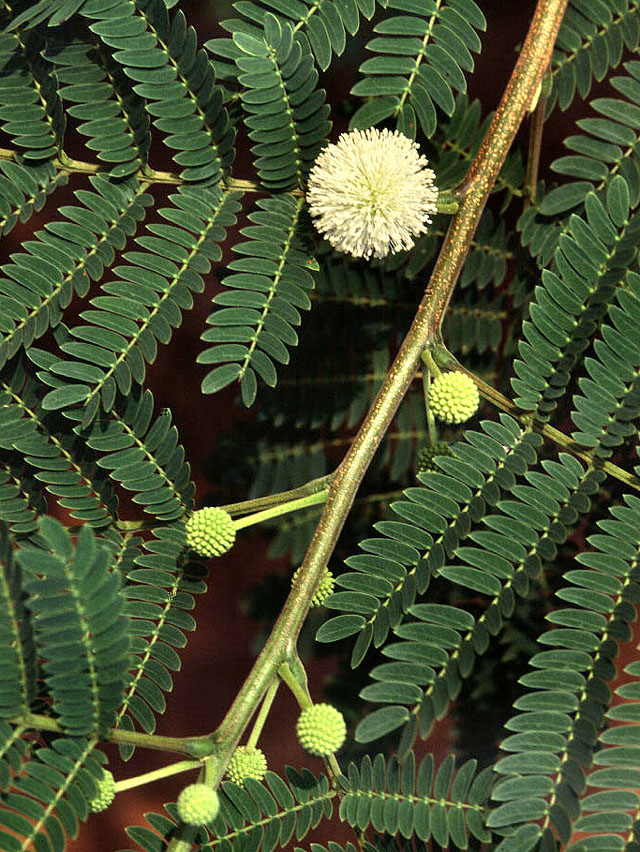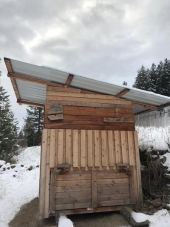The following is from the 1983 Handbook of
Energy Crops by James A. Duke, this is an unpublished work.
Leucaena leucocephala or Leadtree is valued as an excellent protein source for cattle fodder, consumed browsed or harvested, mature or immature, green or dry. The nutritive value is equal to or superior to alfalfa. Leadtree has gained a favorable reputation in land reclamation, erosion control, water conservation, reforestation and soil improvement programs, and is a good cover and green manure crop. The leaves, used as a mulch around other crops, are said to significantly increase their yields. It is said to possess the power of extracting selenium from the soil and concentrating selenium in the seed. This could be used to ameliorate seleniferous soils if the feed were discarded or used for some purpose other than feed. Seeds yield about 25 percent gum worthy of commercial investigation. Seeds after softening are strung as beans into various items of jewelry for tourists in Puerto Rico and the Virgin Islands. In the Philippine Islands, young pods are cooked as a vegetable and seeds are used as a substitute for coffee. Ripe seeds are sometimes eaten parched like popcorn. Wood is hard and heavy (sp. gr. 0.7), the sapwood light yellow, the heartwood yellow-brown to dark brown, used for fuel or charcoal. Plants are used in some countries for shade for black pepper, coffee, cocoa, quinine, and vanilla and for hedges. In many places, however, renegade seedlings have created a noxious weed situation. The dipilatory chemical mimosine has been used, experimentally at least, to shear sheep.
Folk Medicine
Medicinally, the bark is eaten for internal pain. A decoction of the root and bark is taken as a contraceptive, ecbolic, depilatory, or emmenagogue in Latin America. However, in experiments with cattle, leucaena had no effect on conception.
Chemistry
Seeds and young leaves yield 4 percent of mimosine, which causes loss of hair in non-ruminant animals, especially in horses, mules, donkeys and hogs. Leaves also contain 0.08 percent of the glucoside quercetrin. Per g of N, there are 294 mg of arginine, 88 cystine, 125 histidine, 563 isoleucine, 469 leucine, 313 lycine, 100 methionine, 188 methionine + cystine, 294 phenylalanine, 231 threonine, 263 tryosine and 338 mg valine. Leucine protein makes a better animal feed than copra in several amino acids, and is equivalent to alfalfa in most of them. If leucaena makes up half the animals diet, problems result due to mimosine (3–5 percent, on a dry-weight basis, of the protein). Heating the leaves or adding ferrous sulfate reduces the mimosine or its toxicity. Raw young leaves are reported to contain per 100 g edible portion: 68 calories, 79.5 percent moisture, 2.9 g protein, 0.8 g fat, 1S.3 g total carbohydrate, 1.8 g fiber, 1.5 g
ash, 553 mg Ca, and 51 mg P. Raw, tender tops and pods contain per 100 g edible portion: 59 calories, 80.7 percent moisture, 8.4 g protein, 0.9 g fat, 8.8 g total carbohydrate, 3.8 g fiber, 1.2 g ash, 137 mg Ca, 11 mg P. 9.2 mg Fe, 4,730 mg b-carotene equivalent, 0.09 mg riboflavin, 5.4 mg niacin, and 8 mg ascorbic acid. The genus Leucaena is also reported to contain hydrocyanic acid, leucaenine, quercitrin and tannic acid.
Description
Arborescent deciduous small tree or shrub, to 20 m tall, fast-growing; trunk 10–25 cm in diam., forming dense stands; where crowded, slender trunks are formed with short bushy tuft at crown, spreading if singly grown; leaves evergreen, alternate, 10–25 cm long, malodorous when crushed, bipinnate with 3–10 pairs of pinnae, these each with 10–20 pairs of sessile narrowly oblong to lanceolate, gray-green leaflets 1–2 cm long, less than 0.3 cm wide; flowers numerous, axillary on long stalks, white, in dense global heads 1–2 cm across; fruit pod with raised border, flat, thin, becoming dark brown and hard, 10–15 cm long, 1.6–2.5 cm wide, dehiscent at both sutures; seeds copiously produced, 15–30 per pod, oval, flattish, shining brown, 18,000–24,000 per kg; taproot long, strong, well-developed. Tree grown as an annual when harvested for forage. Fl. and fr. nearly throughout the year.
Germplasm
Over 100 cvs and botanical varieties, and several closely related or synonymous species contribute to the leucaena genepool. The commoner 'Hawaiian' type, native to coastal Mexico, is now a widespread tropical weed. It is versatile in adaptation and has become a serious weed in cultivated areas and wastelands. The 'Salvador' type, less aggressive and more tall and tree like, producing twice the biomass as the Hawaiian types. The 'Peru' type, treelike also, branches low down on the trunk, it contains several cvs highly productive of forage. There is quite a variability in mimosine content and cleaner cvs are in order. Colombian cvs and Leucaena pulverulenta have much less mimosine. Assigned to the Middle America Center of Diversity, leadtree or cultivars thereof is reported to exhibit tolerance to aluminum, disease, drought, high pH, heavy soil, laterite, light frost, limestone, low pH, salt, slopes, weeds, and wind. (2n = 104, 36).
Distribution
Native throughout the West Indies from Bahamas and Cuba to Trinidad and Tobago, and from southern Mexico to northern South America. Naturalized northward to southern Texas, California and southern Florida, and southward to Brazil and Chile: also naturalized in Hawaii and the Old World tropics.
Ecology
Requires long, warm, wet growing seasons, doing best under full sun. In Indonesia it is grown to 1,350 m, in Java to 1,080 m. Natural stands are found mostly below 500 m in areas of 6–17 dm rainfall. Its growth rate is slower, at higher altitudes. About one dm per month is required for good growth. The plant is known for its drought tolerance. The leadtree thrives on a wide range of soils, but the most rapid growth is on deep clay soils which are fertile, moist and alkaline. It tolerates aluminum and soils low in iron and phosphorus. It grows best on neutral or alkaline soils, but does poorly on acidic latosols unless Mo, Ca, S and P are added. Its deep root system permits it to tolerate many soil types, from heavy soils to porous coral. Ranging from Warm Temperate Dry to Moist through Tropical Very Dry to Wet Forest Life Zone, leadtree is reported to tolerate annual precipitation of 1.8 to 41.0 dm (mean of 30 cases = 14.9), annual mean temperature of 14.7 to 27.4°C (mean of 30 cases = 24.0°C), and pH of 4.3 to 8.7 (mean of 21 cases = 6.1).
Cultivation
Trees, propagated by seed or cuttings coppice well. Some seedlings less than one-year old will produce viable seed. Seeds remain viable from several months to several years. The hard waxy seedcoat makes scarification necessary before planting. For forage, seed should be sown 2.5–7.5 cm deep, planting at onset of wet season. Leadtree responds favorably to fertilizer and lime. Irrigation and cultivation may be necessary. The crop soon produces a dense stand.
Harvesting
The crop can be cut at any stage for silage or fodder.
Yields and Economics
Leadtree produced 56 MT/ha/year green forage in Hawaii at 24 m altitude. With adequate moisture yields of 80 MT/ha have been obtained. Two year old trees have yielded 4.5–7 kg pods per tree. Duke (1981a) reported annual DM yields are ca 2–20 MT/ha, equivalent to up to 4,300 kg protein per hectare, nearly double the yields of alfalfa. In his pphytomass files, Duke (1981b) reports DM yields of 2–13 MT/ha/yr in Australia, 14–16 in Brazil, 15–20 in Cuba, 35 in Mauritius, 13 in New Guinea, 15–19 in Taiwan and 3–21 in the Virgin Islands.
Energy
With its rhizobium, leucaena can fix more than 500 kg N/ha. On 3 to 8 year trees, annual wood increments vary from 24 to over 100 m3/ha averaging 30 to 40. Dry leucaena wood has 39% the calorific value of fuel oil (10,000 cal/kg), lecaena charcoal 72.5%. In , Molokai, Hawaii (Brewbaker 1980) a 400-ha farm of Leucaena leucocephala on a four year rotation is expected to fuel a two megawatt facility producing 11.6 million KWh/yr. This will replace about 22,000 barrels of diesel. "Wood yields of the giant Leucaena equal or exceed those of other tropical trees and can be the equivalent annually of 30 barrels of oil per acre." Conservatively, rounding their 22,000 barrels per year down to 20,000 barrels, or about half of Panama's daily import, two 400-ha farms may satisfy one day's requirement for Panama, and 730 400-ha farms may satisfy annual requirements or 292,000 ha. Conservatively again, 300,000 ha of Leucaena could satisfy Panama's current energy requirements, providing in the process more than 450,000 metric tons of nitrogen-rich dry macter using the assumptions adopted by Brewbaker (1980). (Curtis and Duke, 1982)
According to NAS (1977b) the fertilizer value of the "fines" is as follows:
N 2.2–4.3%
P 0.2–0.4
K 1.3–4.0
Ca 0.8–2.0
Mg 0.4–1.0
Even under favorable conditions, continual browsing, or cutting and removing the wood or foliage will deplete a Leucaena plant of some vital nutrients; fertilization is then required, particularly P, S, Ca, Mo, and Zn. "It adapts badly to acid soils. Lime pelleting addition of a special Rhizobium strain as well as fertilizer containing Mo, P, S, and Ca are needed to get it started. Leucaena also grows poorly in high-alumina soil-5 and requires careful fertilization with phosphate and calcium. With fertilization, good yields are possible in aluminous soils." Small lateral roots near the soil surface carry Nitrogen-fixing Rhizobium nodules which are usually 2.5–15 mm in diameter, frequently multiobed. Functioning nodules are bright pink inside. The Leucaena-Rhizobium partnership is capable of annually fixing more than 500 kg/i (200 metric tons/400 ha). In 1974 Panama consumed 14,400 MT Nitrogen, probably imported. Apparently IRHE and RENARE have discussed using Eucalyptus for their fuel farms, with seed from Australia. Presumably the seeds will be from species or ecotypes adapted to Tropical Moist Forest of Darien. Many species of Eucalyptus may not adapt to such tropical heat and humidity conditions. Leucaena may be more adapted to the climate if not the soil. Many ecologists and foresters would recommend first an examination of the native species already adapted to an area, then consider the existing introduced species before introducing new aliens. Too often the alien species, introduced without its natural enemies, may propagate and invade to become a weed. Almost all species recommended to us as a biomass candidate including many of the botanochemical species have great weed potential.
Biotic Factors
Leucaena is relatively resistant to the pests and diseases prevalent in Hawaii, but extensive plantation culture may invite the breakdown of this apparent resistance. Twig borers, seed weevils and termites, as well as damping off may hinder the plant. Herbivorous mammals may be fond of the seedlings. Bananas may do better in the shade of leucaena than in full sunlight due to reduced damage by Sigatoka disease.
Now, what this study tells us is that the roots do indeed have nodes of nitrogen fixing bacteria (Rhizobium), That using the leaves and pods as soil amendments is very beneficial.
It also mentions that it is a prime fodder tree for livestock.
If you are going to use the wood in a growing mound, it will work just as any other wood, unless you are planting the near surface roots that contain the Rhizobium nodules, you will benefit greatly by using high nitrogen amendments as the between log fill (leaves, pods, spent coffee grounds, etc.).
Once you have built a layer, water it and continue upward.
Good luck with your growing mound, it should perform quite nicely.


















 1
1









 1
1




























 1
1

























 1
1










 Seems I knew this but have forgotten. I buried some branches in a sheet mulch garden, and they surely stayed moist, but maybe they didn't have any contact with soil and that's why they haven't rooted. Funny. Anyway, I'll keep this in mind! Thanks a ton
Seems I knew this but have forgotten. I buried some branches in a sheet mulch garden, and they surely stayed moist, but maybe they didn't have any contact with soil and that's why they haven't rooted. Funny. Anyway, I'll keep this in mind! Thanks a ton  )
)



































